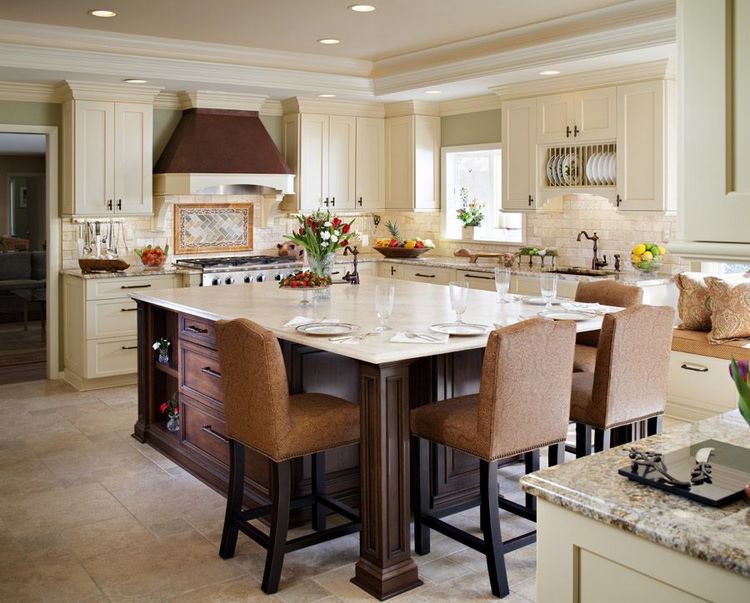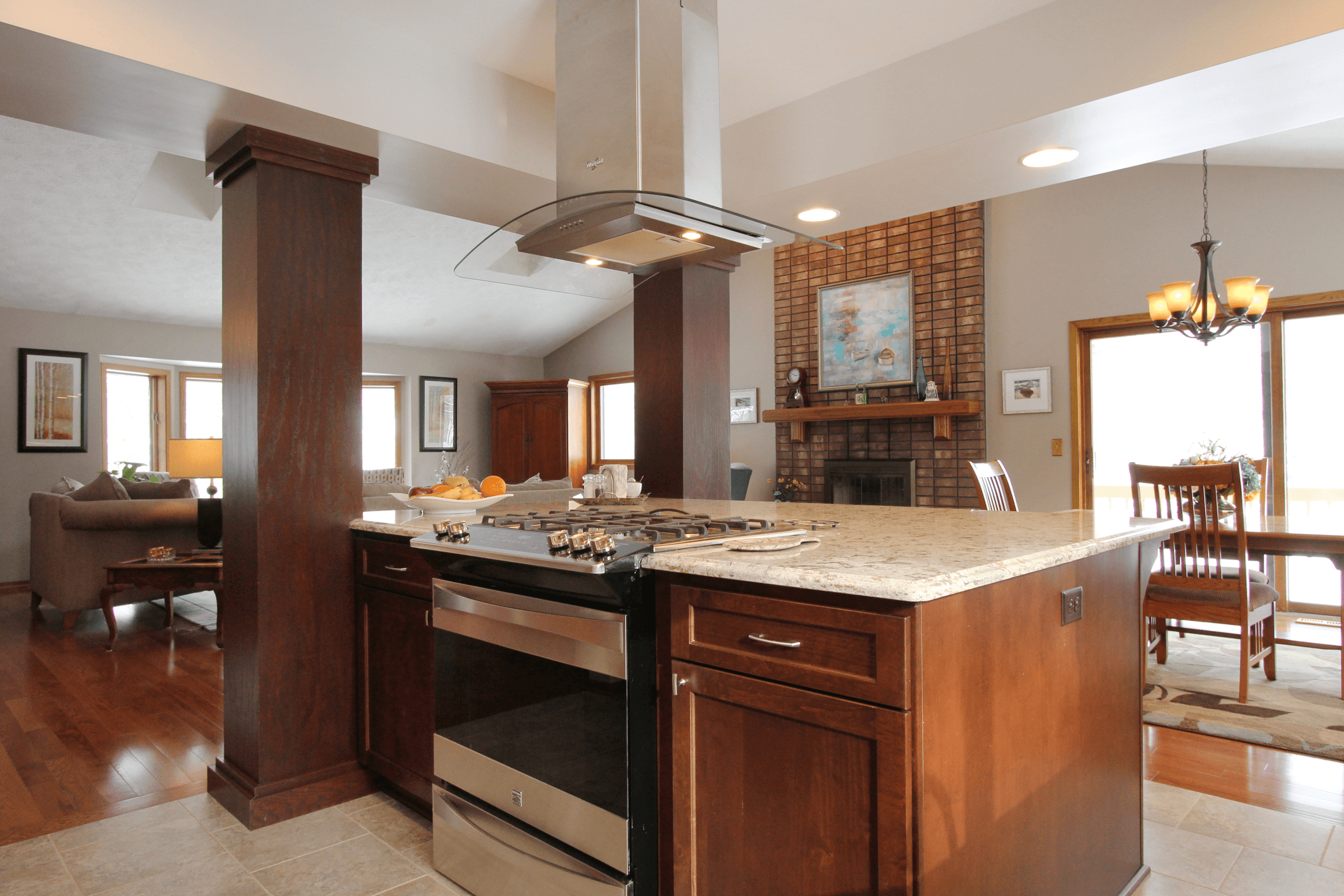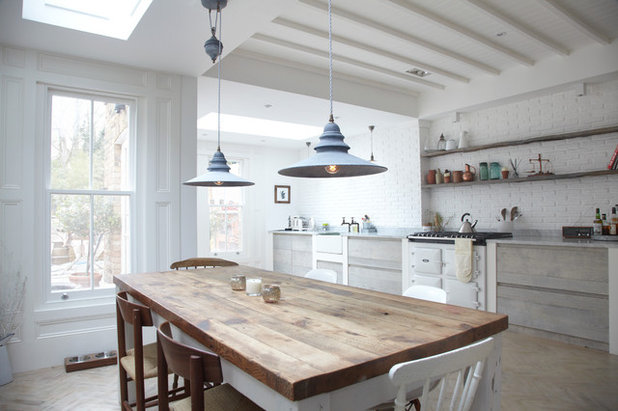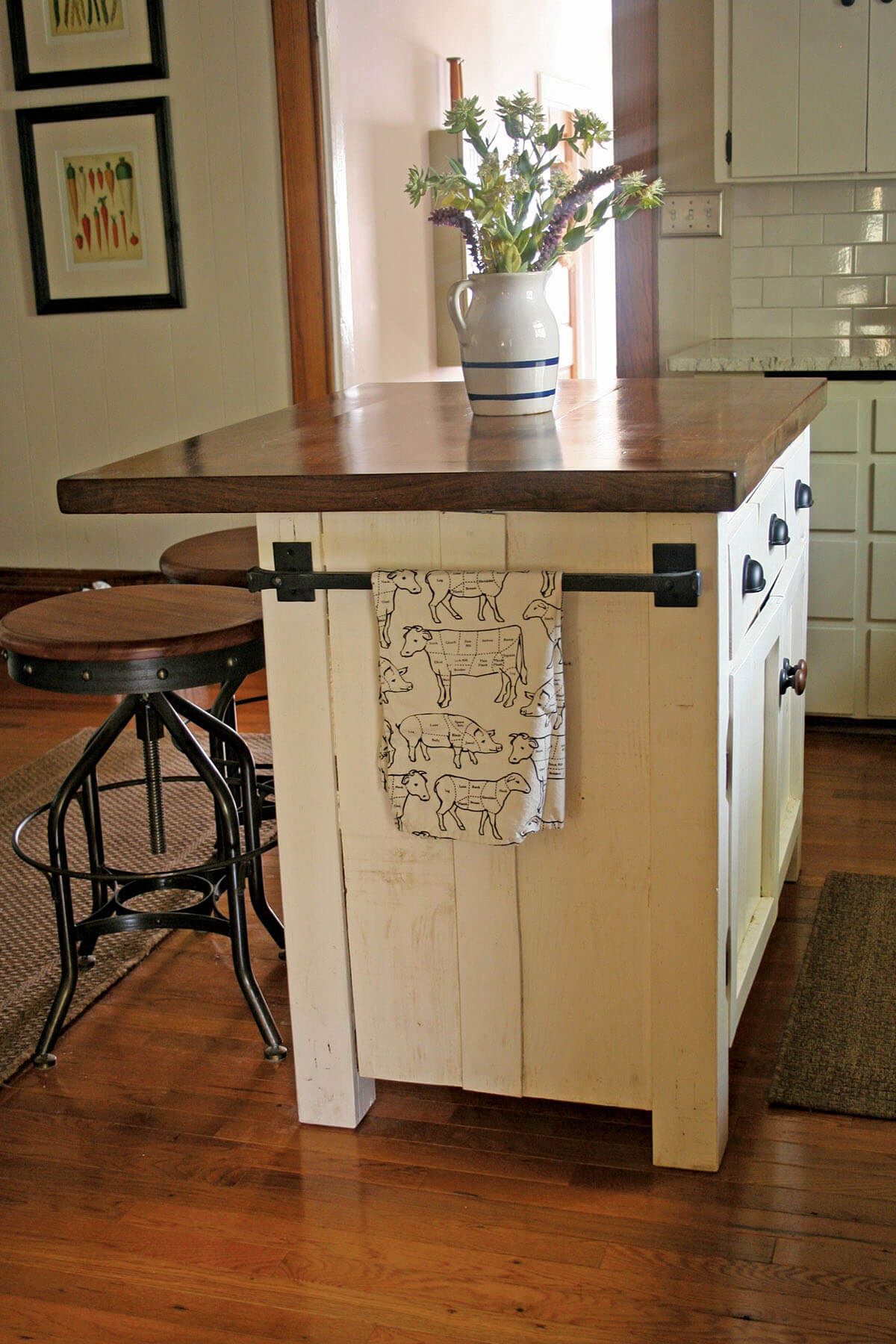When it comes to designing a kitchen, one of the most important decisions is choosing between an island or a traditional kitchen table. While a kitchen table may seem like the more traditional choice, using an island instead can offer numerous benefits in terms of functionality and style. Firstly, an island provides additional counter space, making it easier to prepare and cook meals. It can also serve as a casual dining area, eliminating the need for a separate dining room or formal dining table. This can be especially useful for smaller homes or apartments where space is limited. Additionally, islands often come with built-in storage options such as shelves, drawers, and cabinets, providing more storage space for kitchen essentials. This can help reduce clutter and keep the kitchen organized and tidy. Lastly, islands can add a touch of elegance and sophistication to a kitchen. With a variety of designs and materials available, an island can be customized to fit any style or aesthetic, making it a statement piece in the kitchen.1. Benefits of Using an Island Instead of a Kitchen Table
There are many creative ways to incorporate an island into your kitchen design. One popular option is to use the island as a divider between the kitchen and living or dining area. This not only creates a visual separation of space but also allows for more interaction between those in the kitchen and those in the living or dining area. Another creative option is to use a mobile island that can be moved around the kitchen as needed. This is especially useful for those who have limited space and need the flexibility to rearrange their kitchen layout. Mobile islands also often come with wheels, making them easy to move and store away when not in use. If you have a larger kitchen space, consider incorporating multiple islands into the design. This can create a unique and functional layout, with separate areas for cooking, dining, and socializing.2. Creative Ways to Incorporate an Island into Your Kitchen
When choosing an island for your kitchen, there are a few important factors to consider. Firstly, think about the size and layout of your kitchen. If you have a smaller kitchen, a smaller island may be more suitable to avoid overcrowding the space. On the other hand, a larger kitchen may be able to accommodate a larger island and still leave enough room for movement and functionality. Next, consider the purpose of the island. If you plan on using it mainly for food preparation and cooking, you may want to opt for an island with a built-in sink and stovetop. However, if the main purpose is for dining and socializing, a simple countertop with seating may be sufficient. Lastly, think about the style and design of the island. It should complement the rest of your kitchen and add to the overall aesthetic. Consider the materials, colors, and finishes to ensure the island fits seamlessly into your kitchen design.3. How to Choose the Right Island for Your Kitchen
One of the main advantages of using an island instead of a kitchen table is the ability to maximize space. With a table, there is typically limited space for storage and functionality. However, an island offers a larger surface area for preparing meals, as well as built-in storage options. To make the most out of your island, consider incorporating additional features such as a built-in wine rack, spice rack, or even a built-in microwave or mini-fridge. This not only adds functionality but also frees up counter space and keeps the kitchen organized. Another way to maximize space with an island is to use it as a dual-purpose piece. For example, you can have a countertop that doubles as a dining table, with stools or chairs placed on one side. This allows for more seating and eliminates the need for a separate dining table.4. Maximizing Space with an Island Instead of a Kitchen Table
Deciding between an island or a kitchen table ultimately depends on your personal preferences and the layout of your home. For those with smaller kitchens, an island may be the better choice as it offers more functionality and storage options without taking up too much space. On the other hand, a traditional kitchen table may be preferred for those who have a larger kitchen or a separate dining room. A kitchen table also offers a more traditional and familiar feel, which may be important for some homeowners. If you have the space and budget, you can also consider incorporating both an island and a kitchen table into your kitchen design. This allows for the best of both worlds and provides ample seating and storage options.5. Island vs. Kitchen Table: Which is Better for Your Home?
One of the greatest advantages of using an island instead of a kitchen table is its versatility. An island can serve many purposes, from a food preparation area to a dining table to a socializing spot. It can also be easily customized to fit your specific needs and preferences. For example, if you enjoy cooking and entertaining, you can opt for a larger island with a built-in stovetop and seating. If you have small children, you can choose a rounded island with no sharp edges for safety. The possibilities are endless, making an island a versatile and practical addition to any kitchen.6. The Versatility of Using an Island Instead of a Kitchen Table
If you decide to use an island as your primary dining table, there are many design ideas to consider. One popular option is to have a long, narrow island with stools or chairs placed on either side. This not only creates a unique and modern look but also allows for more seating and socializing space. You can also opt for a larger island with a built-in dining table extension. This provides a designated dining area while still maintaining the functionality of the island for food preparation and storage. Another design idea is to incorporate different levels into the island, with a higher countertop for food preparation and a lower countertop for dining. This adds visual interest and can also be useful for those who may have difficulty sitting at a regular height table.7. Design Ideas for Using an Island as a Kitchen Table
As with any design decision, there are both pros and cons to using an island instead of a kitchen table. Some of the main advantages have already been discussed, such as added counter space, functionality, and storage options. However, there are also some potential downsides to consider. For example, an island may require additional plumbing and electrical work if you plan on incorporating a sink or stovetop. It may also be more expensive to install and may not be suitable for smaller kitchens with limited space. Overall, it is important to weigh the pros and cons and consider your specific needs and preferences before deciding on an island or kitchen table for your home.8. Pros and Cons of Using an Island Instead of a Kitchen Table
If you choose to use an island as a multi-functional kitchen table, there are a few tips to keep in mind to make it work seamlessly. Firstly, make sure the island is the right height for dining. Standard kitchen countertops are typically 36 inches high, which may be too high for comfortable dining. Consider adding a lower countertop or using bar stools with adjustable heights to accommodate different preferences. Next, make sure there is enough space around the island for movement and seating. Ideally, there should be at least 36 inches of space between the island and other cabinets or walls to ensure easy movement and comfortable seating. Lastly, think about lighting. A hanging pendant light above the island can not only provide necessary task lighting for food preparation but also add to the ambiance and create a designated dining area.9. How to Make an Island Work as a Multi-Functional Kitchen Table
In conclusion, using an island instead of a kitchen table can completely transform the look and functionality of your kitchen. With its added counter space, storage options, and versatility, an island is a practical and stylish addition to any kitchen design. When considering an island for your kitchen, be sure to take into account the size and layout of your kitchen, as well as your specific needs and preferences. With the right design and features, an island can become the centerpiece of your kitchen and enhance your overall living space. So why settle for a traditional kitchen table when you can have the many benefits of an island? Make the switch and see the difference it can make in your home.10. Transforming Your Kitchen with an Island Instead of a Table
Maximizing Space and Style with an Island Instead of a Kitchen Table

The Benefits of Choosing an Island Over a Traditional Kitchen Table
 When it comes to designing a functional and stylish kitchen, homeowners are often faced with the dilemma of choosing between a kitchen table and an island. While a kitchen table may seem like the more traditional and practical choice, there are many benefits to incorporating an island into your kitchen design. Not only does an island provide additional counter space and storage, but it also adds a touch of elegance and versatility to your kitchen. In this article, we will dive into the reasons why using an island instead of a kitchen table is a smart and stylish choice for any home.
When it comes to designing a functional and stylish kitchen, homeowners are often faced with the dilemma of choosing between a kitchen table and an island. While a kitchen table may seem like the more traditional and practical choice, there are many benefits to incorporating an island into your kitchen design. Not only does an island provide additional counter space and storage, but it also adds a touch of elegance and versatility to your kitchen. In this article, we will dive into the reasons why using an island instead of a kitchen table is a smart and stylish choice for any home.
Maximizing Space
 Space
is a precious commodity in any household, and the kitchen is no exception. With the increasing popularity of open-concept living, homeowners are looking for ways to maximize their kitchen space without sacrificing functionality. This is where an island comes in. By choosing an island over a kitchen table, you are freeing up valuable floor space and creating a more open and spacious feel in your kitchen. This is especially beneficial for smaller kitchens where every inch counts. An island also provides additional storage space for appliances, cookware, and other kitchen essentials, helping to keep your countertops clutter-free.
Space
is a precious commodity in any household, and the kitchen is no exception. With the increasing popularity of open-concept living, homeowners are looking for ways to maximize their kitchen space without sacrificing functionality. This is where an island comes in. By choosing an island over a kitchen table, you are freeing up valuable floor space and creating a more open and spacious feel in your kitchen. This is especially beneficial for smaller kitchens where every inch counts. An island also provides additional storage space for appliances, cookware, and other kitchen essentials, helping to keep your countertops clutter-free.
Enhancing Style
 In addition to its functionality, an island can also add a touch of
style
to your kitchen. With various design options available, such as built-in sinks, wine racks, and breakfast bars, an island can be customized to suit your personal taste and complement your existing kitchen decor. It also serves as a focal point in the room, creating a visually appealing and inviting space. An island can also be a great way to incorporate different textures and materials, such as marble or butcher block, adding depth and character to your kitchen design.
In addition to its functionality, an island can also add a touch of
style
to your kitchen. With various design options available, such as built-in sinks, wine racks, and breakfast bars, an island can be customized to suit your personal taste and complement your existing kitchen decor. It also serves as a focal point in the room, creating a visually appealing and inviting space. An island can also be a great way to incorporate different textures and materials, such as marble or butcher block, adding depth and character to your kitchen design.
Versatility in Use
 One of the greatest advantages of using an island instead of a kitchen table is its
versatility
. While a kitchen table is primarily used for dining, an island can serve multiple purposes. It can be used as a prep area while cooking, a spot for kids to do homework, or even as a makeshift bar for entertaining guests. With the addition of bar stools, an island can also serve as a casual dining area, perfect for quick meals or impromptu gatherings. This versatility of use makes an island a practical and efficient choice for any kitchen.
In conclusion, while a kitchen table may seem like the more traditional option, incorporating an island into your kitchen design offers numerous benefits. It maximizes space, enhances style, and provides versatility in use, making it a smart and stylish choice for any homeowner. So why settle for a plain old kitchen table when you can have a multifunctional and elegant island instead? Make the switch and elevate your kitchen design to the next level.
One of the greatest advantages of using an island instead of a kitchen table is its
versatility
. While a kitchen table is primarily used for dining, an island can serve multiple purposes. It can be used as a prep area while cooking, a spot for kids to do homework, or even as a makeshift bar for entertaining guests. With the addition of bar stools, an island can also serve as a casual dining area, perfect for quick meals or impromptu gatherings. This versatility of use makes an island a practical and efficient choice for any kitchen.
In conclusion, while a kitchen table may seem like the more traditional option, incorporating an island into your kitchen design offers numerous benefits. It maximizes space, enhances style, and provides versatility in use, making it a smart and stylish choice for any homeowner. So why settle for a plain old kitchen table when you can have a multifunctional and elegant island instead? Make the switch and elevate your kitchen design to the next level.












/cdn.vox-cdn.com/uploads/chorus_image/image/65889507/0120_Westerly_Reveal_6C_Kitchen_Alt_Angles_Lights_on_15.14.jpg)










:max_bytes(150000):strip_icc()/1-69f68fe8416d45efb237fafe5f90a171.jpeg)
:max_bytes(150000):strip_icc()/DesignWorks-0de9c744887641aea39f0a5f31a47dce.jpg)












:max_bytes(150000):strip_icc()/GettyImages-1398693405-ab1afd6b3c3b41bc990a812e5381d746.jpg)

























































:max_bytes(150000):strip_icc()/farmhouse-style-kitchen-island-7d12569a-85b15b41747441bb8ac9429cbac8bb6b.jpg)






